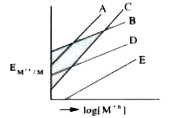The standard electrode potential for the following reaction is + 1.33V.What is potential at pH=2.0?
Cr2O2−7(aq.1M)+14H+(aq)+6e−→2Cr3+(aq.1M0+7H2O(l) Solution in Telugu
+1.820V
+1.990V
+1.608V
+1.0542V
The correct Answer is:D
E−=E0−0.0941nlogQ,E=1.33−0.05916log[Cr+3]2[Cr2O−27][H⊕]14
=1.33−0.05916log(1)2(1)×(10−2)14=1.33+0.05916log10−28=1.33+0.05916×(−28)
=1.33→0.2788=1.05212V
Topper's Solved these Questions
- ELECTROCHEMISTRY BOOK - AAKASH SERIESCHAPTER - ELECTROCHEMISTRY EXERCISE - PRACTICE SHEET -5 (LINKED COMPREHENSION TYPE QUESTIONS (PASSAGE-I))
3 Videos
- ELECTROCHEMISTRY BOOK - AAKASH SERIESCHAPTER - ELECTROCHEMISTRY EXERCISE - PRACTICE SHEET -5 (LINKED COMPREHENSION TYPE QUESTIONS (PASSAGE-II))
3 Videos
- ELECTROCHEMISTRY BOOK - AAKASH SERIESCHAPTER - ELECTROCHEMISTRY EXERCISE - PRACTICE SHEET -4 (INTEGER ANSWER TYPE QUESTIONS )
6 Videos
- DILUTE SOLUTIONSBOOK - AAKASH SERIESCHAPTER - DILUTE SOLUTIONSEXERCISE - EXERCISE - 1.2
55 Videos
- ELEMENTS OF D - BLOCKBOOK - AAKASH SERIESCHAPTER - ELEMENTS OF D - BLOCKEXERCISE - EXERCISE - 5.2
33 Videos
Similar Questions
Nernst equation gives the variation of potential of an electrode based on activity of ions temperature and pressure. The equation is
E=E∘−2.303RTnFlogQ(or)E=E∘−0.0591nlogQ
E∘= Standard potential and 'Q' is the reaction quotient.
What is the reduction potential of a hydrogen electrode in an aqueous solution containing 0.1 M NH4OH,(Kb=10−5), ?
View SolutionFor metal electrodes show the variation in their reduction potential as shown.

Which is the most reactive metal ?
View SolutionDuring electrolysis of one mole or aq HCOOK . How many moles of H2 is formed overall ?
View SolutionWhat are the factor on-which solubility depends on ?
View SolutionGive some examples for the ions with pseudo inert gas electronic configuration.
View SolutionThe electrode with reaction :Cr2O2−7(aq)+14H⊕(aq)+6e−→2Cr3+(aq)+7H2O can be represented as
View SolutionThe standard electrode potential for the following reaction is +1.33V . What is the potential at pH =2.0 ? Cr_(2)O_(7)^(2-)(aq,1M)+14H^(+)(aq)+6e^(-) rarr 2Cr^(3+)(aq. 1M)+7H_(2)O(l)
View SolutionThe cell reaction Cr2O2−7(aq)+14H+(aq)+6Fe2+(aq)→6Fe3+(aq)+2Cr3+(aq)+7H2O(l) is best represented by:
View Solutionwhat is the standard electrode potential for the reduction of HClO?
HClO(aq)+H+(aq+2e−→Cl−(aq)+H2O(l)
Given: Cr2(aq)→Cr3+(aq)+e−,E∘=0.41V
HClO(aq)+H+(aq)+2Cr2+(aq)→2Cr3+(aq)+H2O(l),E∘=1.80
View SolutionThe standard electrode potential for the following reaction is +1.33 V. What is the potential at pH=2.0? Cr_(2)O_(7)^(2-)(aq,1M)+14H^(+)(aq)+6e^(-)to2Cr^(3+)(aq,1M)+7H_(2)O(l)
View SolutionThe standard electrode potential for the following reaction is −0.57 V. What is the potential at pH=12.0 ?
TeO2−3(aq,1M)+3H2O(l)+4e−→Te(s)+6OH−(aq)
View SolutionWrite cell representation for following cells
Cr2O2−2(a)+14H+(aq)+6Fe2+(aq)→6Fe3+(aq)+2Cr3+(aq)+2Cr3+(aq)+7H2O(l)
View Solutionनिम्नलिखित अभिक्रियाओं वाले गैल्वेनिक सेल का मानक सेल विभव परिकलित कीजिए।
2Cr(s)+3Cd+2(aq)→2Cr+3(aq)+3Cd(s)
Fe+2(aq)+Ag+(aq)→Fe+3(aq)+Ag(s)
E^0(Cd+2/Cd)= -0.4
E^0(Cr+3/Cr)= -0.74
E^0(Ag+/Ag)= 0.8
E^0(fe+3/fe+2)= 0.77
View SolutionStandard electrode potential data are used for understanding the stability of an oxidant in a redox titration . Some half reactions and their standard potentials are given below : MnO_4^(-) (aq) +8H^(+)(aq)+5e^(-)rarrMn^(2+)(aq)+4H_2O(l) " "E^@=1.51V Cr_2O_7^(2-) (aq)+14H^(+)(aq)+6e^(-) rarr 2Cr^(3+)(aq)+7H_2O(l) " "E^@=1.38V Fe^(3+)(aq)+e^(-) rarr Fe^(2+)(aq) " "E^@=0.77V Cl_2(g)+2e^(-) rarr2Cl^(-) (aq)" "E^@=1.40V Identify the only incorrect statement regarding the quantitative estirnation of aqueous Fe(NO_3)_2 .
View SolutionThe cell reaction Cr2O2−7(aq)+14H+(aq)+6Fe2+(aq)→6Fe3+(aq)+2Cr3+(aq)+7H2O(l) is best represented by:
View Solution
